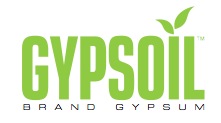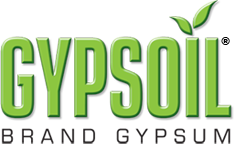News Releases
Media inquiries
Using gypsum to improve soil quality is a popular topic for farm and agricultural inflencer audiences. Please contact our communications consultant Karen Bernick at 1-866-GYPSOIL (497-7645) if you have questions, need story ideas, photos or want to set up interviews with a GYPSOIL team member. GYPSOIL also participates in many national trade shows and meetings including Ag Media Summit, Commodity Classic, National No Tillage Conference and Farm Progress show to name a few.
to improve soil quality is a popular topic for farm and agricultural inflencer audiences. Please contact our communications consultant Karen Bernick at 1-866-GYPSOIL (497-7645) if you have questions, need story ideas, photos or want to set up interviews with a GYPSOIL team member. GYPSOIL also participates in many national trade shows and meetings including Ag Media Summit, Commodity Classic, National No Tillage Conference and Farm Progress show to name a few.
High resolution photos for current news release available here.
Recorded and Powerpoint presentations from the 2014 Midwest Soil Improvement Symposium can be found on the Symposium page.
Highlights from the 2014 press conference at Ohio Farm Science Review.
A collection of general press releases can be found below:
Gypsum potential benefits, experiences highlighted at UW symposium

FOR IMMEDIATE RELEASE

The Midwest Soil Improvement Symposium: Research and Practical Insights into Using Gypsum was a landmark scientific meeting held August 23, 2011, at the University of Wisconsin Arlington Ag Research Station. Speakers included leading researchers and gypsum experts from across the country, in addition to growers experienced using it in their operations. The audience was primarily Certified Crop Advisors and others who advise growers in crop production methods, including soil quality management.
September 1, 2011 Chicago, IL - A growing body of research shows that applying gypsum to agricultural land offers many potential benefits to soil and water quality and crop productivity. Gypsum was the focus of the Midwest Soil Improvement Symposium: Research and Practical Insights into Using Gypsum held August 23 at the University of Wisconsin (UW) Arlington Ag Research Station. Co-sponsors for the event included the UW College of Agriculture and Life Sciences (CALS); UW-Extension; the Conservation Technology Information Center and GYPSOILTM.
Research indicates that gypsum makes soils more permeable to rainfall, alleviates aluminum toxicity and supplies soils with calcium and sulfur, an often- depleted soil nutrient. Gypsum applications also improve particle aggregation, reduce erosion and have been shown to help keep phosphorus and other nutrients from running off agricultural fields.
In addition to research findings, application recommendations and background on the production of gypsum in flue gas desulfurization (FGD) systems at certain coal fired utility plants was presented. Information documenting the safety of FGD gypsum use in agriculture was also presented.
Saving soil, nutrients
USDA Agricultural Research Service soil scientist Dr. Darrell Norton outlined findings from his comprehensive evaluations of gypsum’s impact on soil erosion, nutrient runoff, sediment loading, water infiltration and surface cracking. He is a researcher at the ARS National Soil Erosion Research Lab in West Fayette, IN.
Norton found in a series of rainfall simulator experiments that soil loss is reduced by more than 50 percent when gypsum is applied at a rate of one ton per acre. He explained that gypsum prevents soil particles from detaching during rainfall events and being lost in surface water runoff. See Figure 1.
Keeping soil in place has huge environmental impacts. “Sediment is the number one source of pollution in water,” said Norton, highlighting problems with sediment loading in the Maumee River Basin in Western Lake Erie in OH and Lower Fox River Watershed in Green Bay in WI.
Norton also discussed research findings showing gypsum significantly reduces runoff and also soluble phosphorus levels in topsoil. Also see Figure 1. Studies in Wisconsin, Alabama and Georgia point to similar results.
Symposium panelist Rodney Rulon, a corn and soybean grower who uses gypsum on his family’s 6000-acre no-till operation in Arcadia, IN, emphasized both the environmental and agronomic significance of avoiding soil and water losses.
“There is a cost to everything that leaves your farm, whether it runs off the top, or through a tile,’ Rulon said. “Keeping water for the plant has a benefit to the yield. Keeping water from running off and carrying soil -- you can’t replace that organic matter easily. And fertilizer is terribly expensive -- there is no reason to let it leave our farm.”
Rulon says gypsum is an important tool in his no-till management system, which also includes the use of cover crops and an intense nutrient management system for manure generated at his family’s 500-sow, farrow-to-finish swine operation. “We have incorporated gypsum as part of a system,” said Rulon. “It really seems to be working well and our soil quality and sustainability is improving.”
Sulfur supplement
Dr. Warren Dick, a longtime gypsum researcher and professor in Environmental and Natural Resources at The Ohio State University, Wooster, OH, presented several research reports where gypsum, used as a sulfur source, raised yields in a variety of crops including corn, soybeans, alfalfa.
Dick highlighted a 2003 study showing corn response to gypsum that supplied sulfur at a rate of 30 lbs./acre. “We increased the yield from 182 bu./acre to 193,” said Dick.
His research also suggests that response to sulfur and nitrogen use efficiency are correlated. “If you don’t satisfy the sulfur nutrient part of the crop it can’t really use the nitrogen part either,” Dick said.
Dick also shared results from several alfalfa studies showing the benefit of using gypsum to improve forage yield and quality, including cumulative 2000-2002 data from an OSU study showing an 18 percent increase in alfalfa tonnage in a gypsum-treated field vs. the control with no gypsum. “Gypsum is an excellent source of sulfur,” said Dick.
No-till operator Nick Miller uses gypsum to help decrease compaction, maximize moisture availability and raise yields at his family’s Oconomowoc, WI, 3600-acre farm.
Miller told the symposium audience of roughly 190 crop consultants, researchers, extension advisors, agronomy specialists and growers that he has seen immediate improvements in soybean yields in fields where gypsum was used. He and his family have applied FGD gypsum at a rate of one ton/acre per year on much of their ground beginning in the fall of 2009.
Results have been dramatic, according to Miller. In one soybean field, the Miller’s ten-year average yield was 40-45 bushels/acre before gypsum was applied. After a single gypsum application, yield in the same field was 65 bu./acre, according to Miller. He attributes the dramatic soybean yield increase to the 13- 18 percent sulfur supplied by the gypsum.
Fighting aluminum toxicity and soil structure problems
Dr. Harry Schomberg, a soil researcher at the USDA Agricultural Research Service in Watkinsville, GA, explained that gypsum mitigates the toxic aluminum layer often found in heavily weathered type soils common in the south.
“If you apply gypsum (calcium sulfate dihydrate), calcium moves the aluminum down in that profile and you can get roots growing further down, taking up nutrients and you get bigger plants,” Schomberg said.
Miller says he is seeing soil structure changes in his fields, especially in areas where ponding has been prevalent. “We had a 50-acre field where we hadn’t been able to have a crop in the low area in the last three years due to (standing) water. With one application of gypsum, the water filtrated through and the roots got air,” Miller said. He said the soybeans yielded 110 bushels in the low spot.
Rulon also recalls dramatic evidence of positive changes in soil structure. He says color, tilth, and texture of his soils are vastly different from what he observed when he was using a more conventional system. “The soil doesn’t look the same as it did,” says Rulon.
Application tips
Ron Chamberlain, director of gypsum programs for Beneficial Reuse Management, marketers of GYPSOILTM brand gypsum, presented several gypsum application tips, including handling and spreading methods, application timing and rate recommendations.
Chamberlain recommended applying gypsum with a fertilizer or litter spreader, ideally equipped with a stainless steel box with steep sides (45°angles) and a wide belt. Twin spinners are important to ensure a wide, uniform spread pattern. In absence of a stainless steel box, graphite film coating or plastic liners can be used to assure the gypsum slides easily onto the belt. Because particle size is so small, gypsum can bridge if equipment isn’t set properly. Care should also be taken when storing to avoid moisture saturation with rainfall.
When is the best time to apply it? “Apply anytime it is appropriate to be in the field without damaging the field or crop with the application equipment,” Chamberlain explained.
Rates are typically 300 to 500 lbs. per acre for sulfur supplementation and one to two tons per acre every one to two years for soil amendment, according to Chamberlain. He said delivered and spread price on gypsum is between $25 and $45/ton.
GYPSOIL's mission is to make a positive impact in our customers’ soil while conserving natural resources and protecting the environment.
Symposium speakers included:
- Dr. Harry H. Schomberg, Ecologist, J. Phil Campbell, Sr, National Resource Conservation Center, USDA-Agricultural Research Service, Watkinsville, GA;
- Dr. Warren Dick, Professor, Environmental and Natural Resources, Ohio State University, Wooster, OH;
- Dr. Dexter B. Watts, Research Soil Scientist, USDA-Agricultural Research Service, Auburn, AL;
- Dr. Richard Wolkowski, UW-Madison; and Dr. Meghan Buckley of the UW-Stevens Point;
- Dr. Darrell Norton, Soil Scientist, National Soil Erosion Research Lab, USDA-Agricultural Research Service, West Lafayette, IN;
- Dr. Rufus Chaney, Research Agronomist, Environmental Management and Byproduct Utilization Laboratory, USDA-Agricultural Research Service, Beltsville, MD;
- Ron Chamberlain, director of gypsum programs for Beneficial Reuse Management, marketer of GYPSOILTM brand gypsum;
- John A. Andersen, Jr., President, Greenleaf Advisors Limited, Wilmette, IL, will provide an overview of the environmental impact of agricultural application of byproduct gypsum;
- Bob Paulson, Environmental Consultant, We Energies, Milwaukee, WI, will give background on gypsum production and supply.
Grower panelists included:
- Rodney Rulon, Arcadia, IN;
- Nick Miller, Oconomowoc, WI;
- Jack Maloney, Brownsburg, IN;
- Tom Greil, Waterford, WI;
- Larry Strupp, Slinger, WI;
- Scott Stoffel, West Bend, WI; and
- Dan Craig, Vernon, WI.

Photos
Indiana growers Rodney Rulon (left) and Jack Maloney (right) look on as Nick Miller explains how he uses gypsum to add sulfur and improve soil structure at his Oconomowoc, WI, farm.
Dr. Darrell Norton, a researcher at the USDA-Agricultural Research Service National Soil Erosion Research Lab in West Lafayette, IN, explains how gypsum creates healthier soils, higher yields, cleaner water and provides other environmental benefits.
University of Wisconsin (UW) College of Agriculture and Life Sciences (CALS) soil scientists (from left) Drs. Richard Wolkowski (Emeritus) and Birl Lowery (Professor, UW Soil Science) describe gypsum trials now underway in Wisconsin at a plot tour.
Ron Chamberlain, director of gypsum programs for Beneficial Reuse Management, marketers of GYPSOIL™ brand gypsum, presented gypsum application tips.






